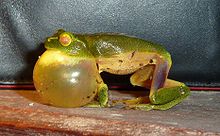Dainty green tree frog
| Dainty green tree frog | |
|---|---|

| |
| Ranoidea gracilenta calling | |
| Scientific classification | |
| Domain: | Eukaryota |
| Kingdom: | Animalia |
| Phylum: | Chordata |
| Class: | Amphibia |
| Order: | Anura |
| Family: | Hylidae |
| Genus: | Ranoidea |
| Species: | R. gracilenta
|
| Binomial name | |
| Ranoidea gracilenta (Peters, 1869)
| |

| |
| Distribution of the dainty green tree frog | |
The dainty green tree frog (Ranoidea gracilenta), also known as the graceful tree frog, is a species of
Description
The dainty green tree frog is a slender, medium-sized frog, reaching a length of 45 millimetres (1.8 in). It is a rich green on its dorsal surface, with a yellow ventral surface. It has a coarse, granular skin with bright orange eyes; some specimens have a light blue ring following the circumference of the eye. The posterior of the thigh is purple-brown or maroon and the
The fingers of L. gracilenta are three-quarters webbed, while the toes are fully webbed.[3]
Ecology and behaviour
The dainty green tree frog is commonly found in vegetation emerging from the water in streams and swamps, often in temporary water. It is found in a range of habitats, including rainforest, woodland and forest. It is commonly found near human developments, in gardens or farms and often enters houses looking for insects. Due to its common occurrence on fruit and vegetable farms, particularly bananas, it is commonly transported around Australia with fruits or vegetables, frequently becoming a lost frog. This is common among many frog species, and is of concern due to the much faster rate at which it can spread disease.
This species is usually seen after heavy rain during spring and summer. It breeds in flooded grassland and small ponds.[4] The males will call during summer after rain, and the call is a long "waa" or "wee". Others describe the call as a long, growl-like 'aarrrc' repeated frequently. Males form noisy choruses during summer breeding season."[3] The eggs are laid in a clear jelly lump in water,[3] and are attached to vegetation. Tadpole development takes about 14 weeks. The tadpoles are a dark brown colour, with a clear, yellow tinge on the body wall.
Captive care
If kept as a pet[5] in Australia, the appropriate permit is required.[6]
References
- ^ Jean-Marc Hero, Ed Meyer, John Clarke (2004) Litoria gracilenta. In: IUCN 2012. IUCN Red List of Threatened Species. Version 2012.2.
- ^ Symbols used by Council. brisbane.qld.gov.au
- ^ ISBN 0-7242-9349-3p. 173.
- ISBN 0-207-15996-3p. 20.
- ISBN 0-9758200-0-1
- ^ Department of Jobs, Precincts and Regions. "Code of Practice for the Welfare of Amphibians in Captivity - Agriculture". agriculture.vic.gov.au. Retrieved 2021-05-27.
Further reading
- "Amphibian Species of the World – Litoria Tschudi, 1838". Archived from the original on 2005-11-29. Retrieved 2005-08-05.
- "Frogs Australia Network – Australian Frog Database – Litoria gracilenta – Graceful Treefrog". Archived from the original on 2006-04-05. Retrieved 2005-08-05.
- Barker, J.; Grigg, G.C.; Tyler,M.J. (1995). A Field Guide to Australian Frogs. Surrey Beatty & Sons. ISBN 0-949324-61-2.
- Department of Environment, Climate Change and Water, New South Wales: Amphibian Keeper's Licence: Species Lists
- https://agriculture.vic.gov.au/livestock-and-animals/animal-welfare-victoria/domestic-animals-act/codes-of-practice/code-of-practice-for-the-welfare-of-amphibians-in-captivity#h2-2
External links
 Data related to Litoria gracilenta at Wikispecies
Data related to Litoria gracilenta at Wikispecies Media related to Ranoidea gracilenta at Wikimedia Commons
Media related to Ranoidea gracilenta at Wikimedia Commons

